3585-33-9
| 中文名 | 二甲氨基锂 |
|---|---|
| 英文名 | lithium,dimethylazanide |
| 中文别名 | 二甲基胺锂 |
| 英文别名 |
6-acetyl-2-methoxy-1-naphthalene
EINECS 222-714-3 lithiumdimethylamide lithium dimethylazanide dimethylamine,lithium salt lithium dimethylamine MFCD00008295 Lithium dimethylamide preparation |
| 密度 | 0.68 g/cm3at 25°C (lit.) |
|---|---|
| 沸点 | 68ºC |
| 分子式 | C2H6LiN |
| 分子量 | 51.01670 |
| 精确质量 | 51.06600 |
| PSA | 3.24000 |
| LogP | 0.01230 |
| 外观性状 | 粉末或块状 |
| 储存条件 | 避光,通风干燥处,密封保存 |
| 稳定性 | 常温常压下稳定 |
| 计算化学 | 1、 氢键供体数量:1 2、 氢键受体数量:1 3、 可旋转化学键数量:0 4、 拓扑分子极性表面积(TPSA):12 5、 重原子数量:4 6、 表面电荷:0 7、 复杂度:2.8 8、 同位素原子数量:0 9、 确定原子立构中心数量:0 10、 不确定原子立构中心数量:0 11、 确定化学键立构中心数量:0 12、 不确定化学键立构中心数量:0 13、 共价键单元数量:3 |
| 更多 | 1. 性状:不确定 2. 密度d(g/mL,25/4℃):0.68 3. 相对蒸汽密度(g/mL,空气=1):不确定 4. 熔点mp(ºC):不确定 5. 沸点(ºC,常压):不确定 6. 沸点 bp ( ºC, 24mm ):68 7. 折射率:不确定8. 闪点fp(ºC):不确定 9. 比旋光度(º):不确定 10. 自燃点或引燃温度(ºC):不确定 11. 蒸气压(kPa,25ºC):不确定 12. 饱和蒸气压(kPa,60ºC):不确定 13. 燃烧热(KJ/mol):不确定 14. 临界温度(ºC):不确定 15. 临界压力(KPa):不确定 16. 油水(辛醇/水)分配系数的对数值:不确定 17. 爆炸上限(%,V/V):不确定 18. 爆炸下限(%,V/V):不确定 19. 溶解性:不确定 |
|
SECTION 1: Identification of the substance/mixture and of the company/undertaking Product identifiers Product name: Lithium dimethylamide REACH No.: A registration number is not available for this substance as the substance or its uses are exempted from registration, the annual tonnage does not require a registration or the registration is envisaged for a later registration deadline.
CAS-No.: 3585-33-9 SECTION 2: Hazards identification Classification of the substance or mixture Classification according to Regulation (EC) No 1272/2008 Pyrophoric solids (Category 1), H250 Substances, which in contact with water, emit flammable gases (Category 2), H261 Skin corrosion (Category 1B), H314 For the full text of the H-Statements mentioned in this Section, see Section 16. Classification according to EU Directives 67/548/EEC or 1999/45/EC F, C Highly flammable, Corrosive R17, R34 For the full text of the R-phrases mentioned in this Section, see Section 16. Label elements Labelling according Regulation (EC) No 1272/2008 Pictogram Signal wordDanger Hazard statement(s) Catches fire spontaneously if exposed to air. In contact with water releases flammable gases. Causes severe skin burns and eye damage. Precautionary statement(s) Do not allow contact with air. P231 + P232Handle under inert gas. Protect from moisture. Wear protective gloves/ protective clothing/ eye protection/ face protection. P305 + P351 + P338IF IN EYES: Rinse cautiously with water for several minutes. Remove contact lenses, if present and easy to do. Continue rinsing. Immediately call a POISON CENTER or doctor/ physician. Store contents under inert gas. Supplemental Hazardnone Statements Other hazards - none SECTION 3: Composition/information on ingredients Substances Formula: C2H6LiN Molecular Weight: 51,02 g/mol CAS-No.: 3585-33-9 EC-No.: 222-714-3 Hazardous ingredients according to Regulation (EC) No 1272/2008 ComponentClassificationConcentration Lithium dimethylamide CAS-No.3585-33-9Pyr. Sol. 1; Water-react. 2;<= 100 % EC-No.222-714-3Skin Corr. 1B; H250, H261, Hazardous ingredients according to Directive 1999/45/EC ComponentClassificationConcentration Lithium dimethylamide CAS-No.3585-33-9F, C, R17 - R34<= 100 % EC-No.222-714-3 For the full text of the H-Statements and R-Phrases mentioned in this Section, see Section 16 SECTION 4: First aid measures Description of first aid measures General advice Consult a physician. Show this safety data sheet to the doctor in attendance. If inhaled If breathed in, move person into fresh air. If not breathing, give artificial respiration. Consult a physician. In case of skin contact Take off contaminated clothing and shoes immediately. Wash off with soap and plenty of water. Consult a physician. In case of eye contact Rinse thoroughly with plenty of water for at least 15 minutes and consult a physician. If swallowed Do NOT induce vomiting. Never give anything by mouth to an unconscious person. Rinse mouth with water. Consult a physician. Most important symptoms and effects, both acute and delayed The most important known symptoms and effects are described in the labelling (see section 2.2) and/or in section 11 Indication of any immediate medical attention and special treatment needed no data available SECTION 5: Firefighting measures Extinguishing media Suitable extinguishing media Dry powder Carbon dioxide (CO2) Unsuitable extinguishing media Water Special hazards arising from the substance or mixture Carbon oxides, nitrogen oxides (NOx), Lithium oxides Advice for firefighters Wear self contained breathing apparatus for fire fighting if necessary. Further information no data available SECTION 6: Accidental release measures Personal precautions, protective equipment and emergency procedures Use personal protective equipment. Avoid dust formation. Avoid breathing vapours, mist or gas. Ensure adequate ventilation. Evacuate personnel to safe areas. Avoid breathing dust. For personal protection see section 8. Environmental precautions Prevent further leakage or spillage if safe to do so. Do not let product enter drains. Methods and materials for containment and cleaning up Sweep up and shovel. Contain spillage, and then collect with an electrically protected vacuum cleaner or by wet-brushing and place in container for disposal according to local regulations (see section 13). Do not flush with water. Keep in suitable, closed containers for disposal. Contain spillage, pick up with an electrically protected vacuum cleaner or by wet-brushing and transfer to a container for disposal according to local regulations (see section 13). Reference to other sections For disposal see section 13. SECTION 7: Handling and storage Precautions for safe handling Avoid formation of dust and aerosols. Provide appropriate exhaust ventilation at places where dust is formed.Keep away from sources of ignition - No smoking. For precautions see section 2.2. Conditions for safe storage, including any incompatibilities Store in cool place. Keep container tightly closed in a dry and well-ventilated place. Never allow product to get in contact with water during storage. Handle and store under inert gas. Moisture sensitive. Specific end use(s) A part from the uses mentioned in section 1.2 no other specific uses are stipulated SECTION 8: Exposure controls/personal protection Control parameters Components with workplace control parameters Exposure controls Appropriate engineering controls Handle in accordance with good industrial hygiene and safety practice. Wash hands before breaks and at the end of workday. Personal protective equipment Eye/face protection Face shield and safety glasses Use equipment for eye protection tested and approved under appropriate government standards such as NIOSH (US) or EN 166(EU). Skin protection Handle with gloves. Gloves must be inspected prior to use. Use proper glove removal technique (without touching glove's outer surface) to avoid skin contact with this product. Dispose of contaminated gloves after use in accordance with applicable laws and good laboratory practices. Wash and dry hands. Protective gloves against thermal risks The selected protective gloves have to satisfy the specifications of EU Directive 89/686/EEC and the standard EN 374 derived from it. Body Protection Complete suit protecting against chemicals, Flame retardant antistatic protective clothing, The type of protective equipment must be selected according to the concentration and amount of the dangerous substance at the specific workplace. Respiratory protection Where risk assessment shows air-purifying respirators are appropriate use a full-face particle respirator type N100 (US) or type P3 (EN 143) respirator cartridges as a backup to engineering controls. If the respirator is the sole means of protection, use a full-face supplied air respirator. Use respirators and components tested and approved under appropriate government standards such as NIOSH (US) or CEN (EU). Control of environmental exposure Prevent further leakage or spillage if safe to do so. Do not let product enter drains. SECTION 9: Physical and chemical properties Information on basic physical and chemical properties a) AppearanceForm: solid Colour: white b) Odourno data available c) Odour Thresholdno data available d) pHno data available e) Melting point/freezingno data available point f) Initial boiling point and no data available boiling range g) Flash pointno data available h) Evapouration rateno data available i) Flammability (solid, gas) no data available j) Upper/lowerno data available flammability or explosive limits k) Vapour pressureno data available l) Vapour densityno data available m) Relative densityno data available n) Water solubilityno data available o) Partition coefficient: n- no data available octanol/water p) Auto-ignitionno data available temperature q) Decompositionno data available temperature r) Viscosityno data available s) Explosive propertiesno data available t) Oxidizing propertiesno data available Other safety information no data available SECTION 10: Stability and reactivity Reactivity no data available Chemical stability Stable under recommended storage conditions. Possibility of hazardous reactions Reacts violently with water. Conditions to avoid Exposure to moisture. Incompatible materials Strong oxidizing agents, acids Hazardous decomposition products Other decomposition products - no data available In the event of fire: see section 5 SECTION 11: Toxicological information Information on toxicological effects Acute toxicity no data available Skin corrosion/irritation no data available Serious eye damage/eye irritation no data available Respiratory or skin sensitisation no data available Germ cell mutagenicity no data available Carcinogenicity IARC:No component of this product present at levels greater than or equal to 0.1% is identified as probable, possible or confirmed human carcinogen by IARC. Reproductive toxicity no data available Specific target organ toxicity - single exposure no data available Specific target organ toxicity - repeated exposure no data available Aspiration hazard no data available Additional Information RTECS: Not available Material is extremely destructive to tissue of the mucous membranes and upper respiratory tract, eyes, and skin., Cough, Shortness of breath, Headache, Nausea SECTION 12: Ecological information Toxicity no data available Persistence and degradability no data available Bioaccumulative potential no data available Mobility in soil no data available Results of PBT and vPvB assessment PBT/vPvB assessment not available as chemical safety assessment not required/not conducted Other adverse effects no data available SECTION 13: Disposal considerations Waste treatment methods Product Burn in a chemical incinerator equipped with an afterburner and scrubber but exert extra care in igniting as this material is highly flammable. Offer surplus and non-recyclable solutions to a licensed disposal company. Contact a licensed professional waste disposal service to dispose of this material. Contaminated packaging Dispose of as unused product. SECTION 14: Transport information UN number ADR/RID: 3393IMDG: 3393IATA: 3393 UN proper shipping name ADR/RID: ORGANOMETALLIC SUBSTANCE, SOLID, PYROPHORIC, WATER-REACTIVE (Lithium dimethylamide) IMDG: ORGANOMETALLIC SUBSTANCE, SOLID, PYROPHORIC, WATER-REACTIVE (Lithium dimethylamide) IATA:Organometallic substance, solid, pyrophoric, water-reactive (Lithium dimethylamide) Passenger Aircraft: Not permitted for transport Cargo Aircraft: Not permitted for transport Transport hazard class(es) ADR/RID: 4.2 (4.3)IMDG: 4.2 (4.3)IATA: 4.2 (4.3) Packaging group ADR/RID: IIMDG: IIATA: - Environmental hazards ADR/RID: noIMDG Marine pollutant: noIATA: no Special precautions for user no data available SECTION 15: Regulatory information This safety datasheet complies with the requirements of Regulation (EC) No. 1907/2006. Safety, health and environmental regulations/legislation specific for the substance or mixture no data available Chemical Safety Assessment SECTION 16 - ADDITIONAL INFORMATION N/A |
|
生态学数据: 通常对水是不危害的,若无政府许可,勿将材料排入周围环境
|
| 危害码 (欧洲) | F: Flammable;C: Corrosive;N: Dangerous for the environment; |
|---|---|
| 风险声明 (欧洲) | 17-34-67-65-62-51/53-48/20-11 |
| 安全声明 (欧洲) | 9-16-26-29-33-36/37/39-45-62-27 |
| 危险品运输编码 | UN 3394 4.2/PG 1 |
| 危险类别 | 4.2 |
| 海关编码 | 2924199090 |
|
~% 
3585-33-9 |
| 文献:US2004/210071 A1, ; Page 6 ; |
|
~% 
3585-33-9 |
| 文献:US2007/112039 A1, ; Page/Page column 9 ; US 20070112039 A1 |
|
~% 
3585-33-9 |
| 文献:Tetrahedron, , vol. 42, # 17 p. 4729 - 4742 |
| 上游产品 3 | |
|---|---|
| 下游产品 10 | |
| 海关编码 | 2924199090 |
|---|---|
| 中文概述 | 2924199090. 其他无环酰胺(包括无环氨基甲酸酯)(包括其衍生物及盐). 增值税率:17.0%. 退税率:13.0%. 监管条件:无. 最惠国关税:6.5%. 普通关税:30.0% |
| 申报要素 | 品名, 成分含量, 用途, 包装 |
| Summary | 2924199090. other acyclic amides (including acyclic carbamates) and their derivatives; salts thereof. VAT:17.0%. Tax rebate rate:13.0%. . MFN tariff:6.5%. General tariff:30.0% |












![N-[chloro-bis(2,4,6-trimethylphenyl)germyl]-N-methylmethanamine结构式](https://image.chemsrc.com/caspic/138/202128-02-7.png)


